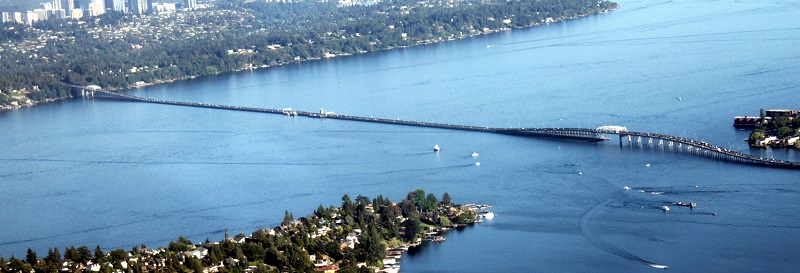State Route 520 Floating Bridge
In March 2016, Washington State in northwest America officially opened the world’s longest floating bridge. The ‘State Route 520 Bridge’ (SR520), as it is known, is a six-lane pontoon structure 2.4 km in length. It was constructed as part of the ‘Connecting Washington’ package of measures, Washington State’s largest and greenest transportation investment.
It replaced a four-lane bridge that was completed in the early-1960s. The bridge boasts bigger and stronger pontoons and anchors than the previous bridge, along with a stormwater collection and treatment system to help improve the water quality of Lake Washington. A bus and carpool lane flows in either direction, as well as a 14 ft-wide bicycle and pedestrian path.
Floating bridges are constructed on large water-tight concrete pontoons rigidly connected end-to-end, upon which the road deck is constructed. Individual bridge pontoons are built on the land before being floated and towed to the bridge site. Once there, they are connected at each end to grounded approach structures, starting at the edge of the floating structure and then pieced together towards the bridge’s centre. Enormous cables hundreds of feet long hold the pontoons in place, connected to anchors buried deep in the lake bed.
A more conventional suspension bridge was not suitable for the location as the deepest point of Lake Washington is 214 ft, meaning that the bridge’s support towers would have to be approximately 630 ft tall, nearly the same height as the Space Needle.
The use of floating bridges is typically limited by the wind and wave forces that are likely to be experienced. The ‘fetch’ is the unobstructed clear distance over the water that wind can travel to the bridge. The longer the fetch, the higher the wind and wave forces will be. Pontoons bend, heave and twist as a result of wind and wave forces, creating large stresses in the pontoons and anchor system. However, even in the event of a ‘100-year storm’ (a storm that statistically has 1% chance of occurring in any given year), the pontoons are designed so that they will not crack, and so the bridge will not sink.
[edit] Related articles on Designing Buildings Wiki
- 7 Engineering Wonders of the World.
- Akashi Kaikyo Bridge.
- Bridge construction.
- Bridges of the world.
- Caisson.
- Chesapeake Bay Bridge-Tunnel.
- Civil engineer.
- Cofferdam.
- Driven piles.
- Illusionist bridge.
- Lucky Knot Bridge.
- Nine Elms to Pimlico bridge.
- Pile foundations.
- Pontoon bridge.
- Queensferry Crossing.
- River engineering.
- Thames barrier.
- The Iron Bridge.
- The Millau Viaduct.
- Water engineering.
[edit] External references
- Washington State - Bridge facts
Featured articles and news
The UK's Modern Industrial Strategy: A 10 year plan
Previous consultation criticism, current key elements and general support with some persisting reservations.
Building Safety Regulator reforms
New roles, new staff and a new fast track service pave the way for a single construction regulator.
Architectural Technologist CPDs and Communications
CIAT CPD… and how you can do it!
Cooling centres and cool spaces
Managing extreme heat in cities by directing the public to places for heat stress relief and water sources.
Winter gardens: A brief history and warm variations
Extending the season with glass in different forms and terms.
Restoring Great Yarmouth's Winter Gardens
Transforming one of the least sustainable constructions imaginable.
Construction Skills Mission Board launch sector drive
Newly formed government and industry collaboration set strategy for recruiting an additional 100,000 construction workers a year.
New Architects Code comes into effect in September 2025
ARB Architects Code of Conduct and Practice available with ongoing consultation regarding guidance.
Welsh Skills Body (Medr) launches ambitious plan
The new skills body brings together funding and regulation of tertiary education and research for the devolved nation.
Paul Gandy FCIOB announced as next CIOB President
Former Tilbury Douglas CEO takes helm.
UK Infrastructure: A 10 Year Strategy. In brief with reactions
With the National Infrastructure and Service Transformation Authority (NISTA).
Ebenezer Howard: inventor of the garden city. Book review.
The Grenfell Tower fire, eight years on
A time to pause and reflect as Dubai tower block fire reported just before anniversary.
Airtightness Topic Guide BSRIA TG 27/2025
Explaining the basics of airtightness, what it is, why it's important, when it's required and how it's carried out.
Construction contract awards hit lowest point of 2025
Plummeting for second consecutive month, intensifying concerns for housing and infrastructure goals.
Understanding Mental Health in the Built Environment 2025
Examining the state of mental health in construction, shedding light on levels of stress, anxiety and depression.






















